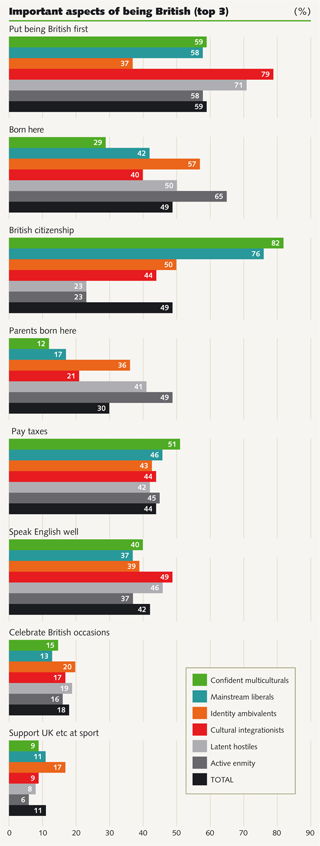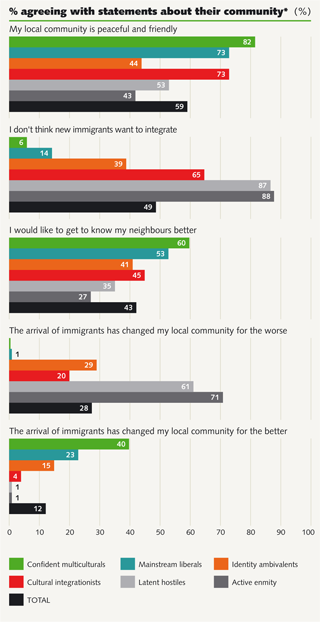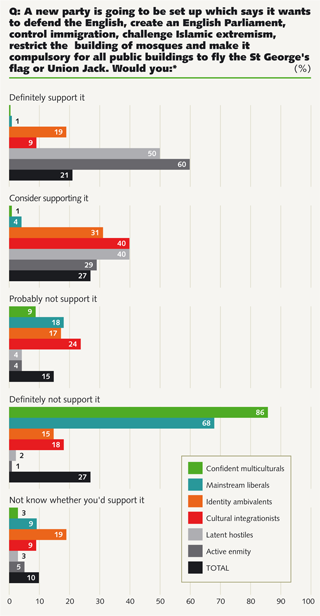Themes
Optimism v Pessimism, Security v Insecurity
One of the major divides is the degree to which the identity ‘tribes’ are optimistic or pessimistic about their own and the country’s future.
There is very high degree of concern across the board that the country is heading in the wrong direction. Eighty-two per cent (82%) consider life in Britain is worse than 10 years ago. Notwithstanding the economic situation, this is very high.

There is a major divide of opinion between the Latent Hostiles / Active Enmity and the rest of the ‘tribes’ when it comes to general expressions (as opposed to the country specific question) of optimism and pessimism.
Modern Britain is most definitely not a country that is currently at ease with itself. Active Enmity and Latent Hostiles are more pessimistic than optimistic by a ratio of three-to-one. The graph below shows how more positive associations of words with the country are to be found on the right hand side of the graph, at the lowest point of the curve. Negative words are found at the highest point. The two groups on the right of the spectrum differ most significantly from the groups on the left on the concepts of ‘soft touch’ and ‘weak’.
There is also a security v insecurity aspect at play here. Security is linked very much with feelings of empowerment. As part of the survey, respondents were asked about their happiness with their life so far and whether their success in life was self or externally determined.

The two categories with the highest disappointment ratio were Active Enmity and Identity Ambivalents (see bar chart below.) Both these groups had relatively high levels of perception of success linked to ‘outside forces’ – 37% and 36% respectively.
There are two points worth making here:
- People do not tend to blame themselves for their own perceived shortcomings
- The proximity of notions of power and security between these two groups has to be a cause for concern when considering potential shifts from one attitude set to another.
The interaction of economy/ standard of living and identity.
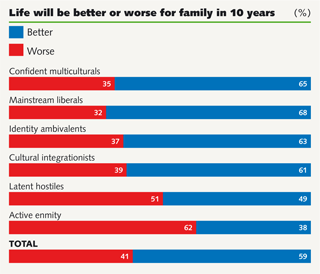
When it comes to their personal and family’s situation, respondents believed that ‘life would be better’ by a margin of 59% to 41%. Again, the same split can be seen between Latent Hostiles and Active Enmity and the rest on this optimism v pessimism question. Both these groups are more pessimistic about their family’s future than the rest:
What is interesting is that the Identity Ambivalents retain a degree of optimism about the future (despite many of them being economically insecure), in a way that Latent Hostiles and Active Enmity do not. A further or deeper period of economic insecurity or even suffering could impact on this over time. For example, unemployment is known to have a severe impact on a person’s long-term well-being.
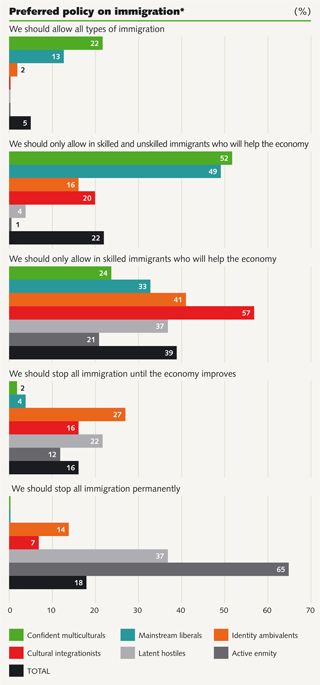
Immigration impacts on this insecurity. Identity Ambivalents are more likely to see this issue through economic glasses than other groups.
The chart left shows that 27% of these Identity Ambivalents agree with the statement: ‘we should stop all immigration until the economy improves.’ Fourteen per cent (14%) of this group believe that all immigration should be permanently stopped, compared to 37% of Latent Hostiles and Active Enmity. Therefore, the latter groups’ outlook on immigration is more likely to be linked to the general state of the economy. The longer their perception of economic weakness, the harder the line they are likely to take on immigration.
The key variables here are change and security: if things change for better then attitudes towards immigration are likely to soften to a certain degree (though it is important not to overstate this); if they worsen then they could harden further.
One other variable that must be considered is the impact of public sector spending cuts. The C2, DE mix of Identity Ambivalents, Latent Hostiles, and Active Enmity is over 50% in each: 54%, 51%, and 64% respectively. In the case of Confident Multiculturals, Mainstream Liberals, and Cultural Integrationists it is less than 50% in each: 19%, 32%, and 32% respectively. Public expenditure cuts will hit C2 and des to a disproportionate extent, because:
- They receive more (proportionate to their income) from the public purse in tax credits, local and public services
- The cuts in many areas, most particularly local services, will hit them harder.
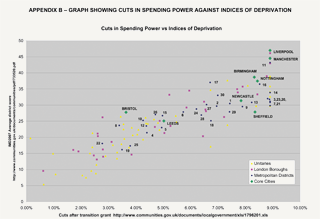 The graph right produced by the campaign group Core Cities15 demonstrates the impact of cuts on central government grants to local authorities, measured against the index of multiple deprivation. 16
The graph right produced by the campaign group Core Cities15 demonstrates the impact of cuts on central government grants to local authorities, measured against the index of multiple deprivation. 16
What this shows is that the cuts to local authority central grants will hit poorer areas harder. Moreover, a total of £81billion of cuts over four years will impact in-work benefits, employment, housing, local services, as well as a VAT and fuel duty rise on top of wages that are declining in real terms.
This consolidation could have a significant impact on the finances and security of many in the Identity Ambivalents, Latent Hostiles and Active Enmity. It is the first of these groups – the ‘squeezed middle’ – which is politically uncertain and where there could be a shift in attitude as the decline in living standards and the squeeze in public support starts to bite.
Englishness, Britishness, Nation and Identity
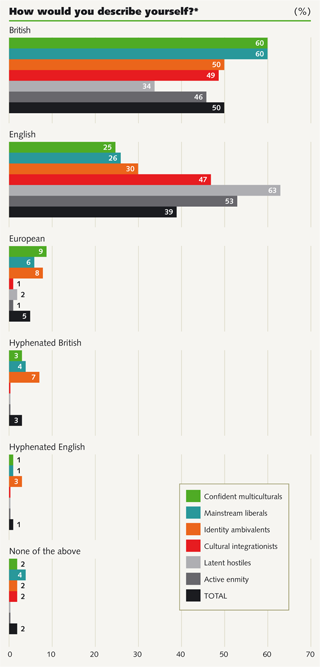 Englishness is back on the political agenda17 and it is absolutely an avowed and expressed identity of a significant number. On a forced choice between British, English, European, hyphenated-British (e.g. Asian British), or none of the above, 60% regard themselves as British and 39% regard themselves as English. If Englishness is the nationality that didn’t dare speak its name, then that is no longer the case.
Englishness is back on the political agenda17 and it is absolutely an avowed and expressed identity of a significant number. On a forced choice between British, English, European, hyphenated-British (e.g. Asian British), or none of the above, 60% regard themselves as British and 39% regard themselves as English. If Englishness is the nationality that didn’t dare speak its name, then that is no longer the case.
Significant numbers now regard themselves as primarily English over British. This is clearly a widespread phenomenon. Moreover, national identity trumps any other notion of overall identity.
Sixty-four per cent (64%) of respondents see nationality, country of birth or country of residence as the most important aspect of their identity. This means that people have far a weaker attachment to the place where they live, their ethnicity or their religion than their national identity. This begs the question: what do people consider the important aspects of being British?
Almost 60% of respondents placed ‘putting being British first’ in their top three choices. Another near-50% put being born here and British citizenship in their top three choices. Thirty per cent (30%) placed ‘parents born here’ in their top three priorities, which seems a relatively high bar for Britishness; it includes almost 50% of Active Enmities (which suggests that acceptance will be a long time coming from that particular group). For many respondents it was not enough to be a citizen, but a good citizen (such as paying taxes and speaking good English) both come in at around 40% of those surveyed.
It is worth noting that 55%+ of Identity Ambivalents regard being born here as an important aspect of Britishness – far more than the Latent Hostiles. Trust is something that is earned over time – and the reservoirs of social trust and capital is a theme which underpins notions of identity.
Minority Attitudes
The evidence from the survey does not suggest that attitudes from minorities are significantly different from white attitudes on a whole range of issues. Even with a sample size of over 5000, only two minority groups produced statistically significant results: ‘Asians’ and ‘blacks’ (and the latter, it should be noted, is with a small sample size.) Therefore it is on these three groups that this analysis is focused.
The area of greatest divergence from the population average is over identity. This is not necessarily surprising. Amongst Asians, 34% consider themselves British first, one per cent (1%) English, 13% ‘hyphenated-English’ and 39% ‘hyphenated-British’ (for black respondents, it is almost the same: 33% British, six per cent (6%) English, three per cent (3%) ‘hyphenated-English’, and 41% ‘hyphenated British’). Asian and black minorities are also more likely to regard religion and ethnicity as the most important element of their identity.
| Most important element of your identity | |||
|---|---|---|---|
| Asian | White | Black* | |
| Nationality | 16% | 37% | 10% |
| Country where you were born | 15% | 25% | 6% |
| Your village/town/city | 8% | 16% | 11% |
| Religion | 24% | 6% | 16% |
| Your estate/neighbourhood/community | 4% | 5% | 11% |
| Ethnicity | 17% | 6% | 40% |
| Country you live in now | 15% | 5% | 5% |
It should be noted, however, that there is not an aggressive anti-nationalism to accompany this proportionately greater ethnic and religious construction of identity. In fact, if anything Asians are just as relaxed and only marginally less proud of symbolic displays of English patriotism such as flying the St.George’s flag.
| How do you feel when see someone fly the St George’s flag? | |||
|---|---|---|---|
| Asian | White | Black* | |
| Proud | 19% | 25% | 14% |
| Irritated | 2% | 5% | 6% |
| Indifferent | 26% | 28% | 44% |
On issue after issue there is a great deal of proximity between different ethnic groups, rather than difference.
On immigration there is a more positive attitude amongst minority groups in general.
| On the whole, immigration into Britain has been a good thing for the country OR On the whole, immigration into Britain has been a bad thing for the country |
|||
|---|---|---|---|
| Asian | White | Black* | |
| Good thing | 57% | 38% | 83% |
| Bad thing | 43% | 63% | 17% |
However, when actual approaches to immigration are detailed, there is broad agreement.
| Preferred policy on immigration | |||
|---|---|---|---|
| Asian | White | Black* | |
| Stop all immigration | 10% | 19% | 4% |
| Stop all immigration until the economy improves | 29% | 15% | 17% |
| Only allow in skilled immigrants who will help the economy | 33% | 40% | 30% |
| Only allow in skilled and unskilled immigrants who will help the economy | 25% | 22% | 39% |
| Allow all types of immigration | 4% | 4% | 10% |
The above table suggests that 39% of Asians and 34% of whites are in a hard anti-immigration camp. Fifty-eight per cent (58%) of Asians and 62% of Whites seem pragmatic towards immigration. Four per cent (4%) of each are ‘open borders’ advocates. And when we consider perceptions of the impact of immigration on different groups, it is easy to understand why, despite a generally more accepting attitude towards immigration, the attitudes of ethnic minority groups converge with the average over the impact immigration has on their personal economic situation and that of the wider economy as a whole .
| Immigrants have put my job at risk | ||
|---|---|---|
| Asian | White | |
| Strongly agree | 16% | 10% |
| Agree | 24% | 13% |
| Neither agree or disagree | 28% | 34% |
| Disagree | 17% | 18% |
| Strongly Disagree | 14% | 26% |
| Immigrants have made it harder to get a fair wage for the work I do | ||
|---|---|---|
| Asian | White | |
| Strongly agree | 15% | 15% |
| Agree | 32% | 19% |
| Neither agree or disagree | 30% | 31% |
| Disagree | 16% | 15% |
| Strongly Disagree | 6% | 20% |
In terms of direct personal impact, more Asians believe immigration has a greater detrimental effect upon than White respondents. This challenges our assumptions about how different groups are responding to identity and immigration.
While the construction of Asian and Black identity varies from that of White Britons, their attitudes and experiences converge. The ethnic politics of identity are neither clear cut nor predictable which means that assumptions are hard to make. People have to be met where they actually are, not where we assume or think they are.
Social Capital v Social Dislocation
The political scientist Robert Putnam has written about the effect of diversity on social capital. 18 Traditional opinion posits that there is a ‘conflict’ for resources as communities socially change: suspicion between groups but solidarity within groups.
Obviously, as resources such as jobs or housing become more scarce this conflict intensifies, even more so in areas which have fallen prey to major economic as well as social change. Putnam’s insight was that rather than diversity (and he was principally writing about ethnic diversity) and change are increasing in-group solidarity it actually leads to reduced in-group solidarity and social isolation.19 He summarises his argument:
“Diversity seems to trigger not in-group/out-group division, but anomie or social isolation.”
Putnam argues that social change creates a ‘turtle effect.’ People withdraw into themselves in reaction to major economic and social upheaval. There could a short-term aspect to this and much of Putnam’s analysis is about the possibility of reversing this ‘turtle effect’ – a question on which he is very positive.
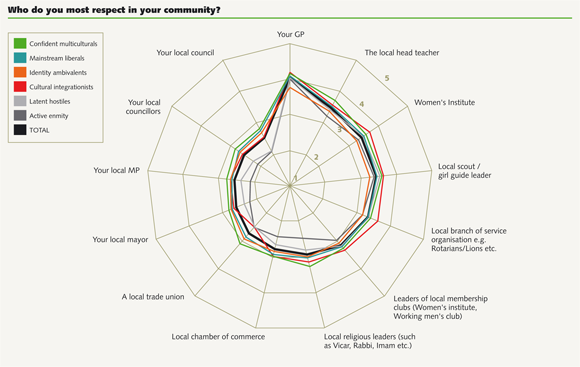
The research in this survey tends to provide some support for the ‘turtle’ theory of change and diversity. There tends to be an association between change and (short term) weak bonds of community. Of course, a raft of other questions would need to be surveyed to obtain a more comprehensive picture of the drivers of attitudes but there are certainly ‘turtle-esque’ characteristics to groups who are more likely to display antagonistic attitudes to others.
Latent Hostiles and Active Enmity are less likely to regard their communities as peaceful and friendly but they are also less interested in ‘getting to know’ their neighbours better. The survey also reveals that Identity Ambivalents are less likely to live in communities that they perceive as ‘peaceful and friendly’ than the population overall. However, they are more likely to want to get to know their neighbours, more likely to think that new immigrants want to integrate, and less likely to think that new immigrants have changed their local community for the worse. It should be noted that this group do contain the majority of BAME voters and there is no objective measure of the degree to which their communities have changed in ethnic terms.
This social dislocation is also underlined by the degree of trust that the different ‘tribes’ have in notable local figures and institutions.
As expected, this web skews right towards a higher degree of trust in community institutions and local services than anything of a political nature. There is, however, a much lower average trust score the further right on the axis one goes:
| Trust Index | |
|---|---|
| Total | 3.04 |
| Confident Multiculturals | 3.24 |
| Mainstream Liberals | 3.12 |
| Identity Ambivalent | 3.02 |
| Cultural Integrationists | 3.14 |
| Latent Hostiles | 2.91 |
| Active Enmity | 2.75 |
The key point here is that social dislocation within communities is an aspect of antipathy. When people become dislocated it is not necessarily to their ‘own group’ that they turn: it is away from social engagement all together. They are not interested in those around them. They have more negative views of outsiders. They are victims of change and view change negatively. In situations of scarce resources this type of social dislocation and even conflict is likely to be more severe.
Working Class Dislocation
The experiences of working-class Britain have been extremely varied over the past few decades. Some in former mining villages, major manufacturing towns cities and former mill towns have experienced loss and dislocation. Others have benefitted from industrial change as new industries have established in new locations, such as Honda in Swindon. Overall, though, there has been a de-skilling, casualisation and flexibilisation of the workforce at lower income levels. Many families now require two incomes, where previously one would have sufficed.
There are still romantic notions of working-class solidarity in the face of this economic change. Much as the evidence suggests there is a ‘turtle response’ to the short-term impact of diversity, this survey also picks up on ‘turtle-like’ responses in working-class communities. These responses exhibit in several ways, with several causes, and are likely to be influenced by economic change, decline of opportunity, the quality of the public realm, social change, and hardship.
It is perhaps of no surprise that many of the areas where the BNP has made its most substantial gains are in the very communities and localities which have experienced the most economic and social change – particularly those places built up around one or two key industries. These include Barking & Dagenham (car industry), Stoke-on-Trent (steel, potteries and coal), Nuneaton (coal and car industry) and Barnsley (coal). This economic upheaval has been accompanied by social upheaval, too, and resulting dislocation. It’s as if the glue that bound the area together, and the people within it, has melted away and left behind a disconnected, dislocated and increasingly resentful population.
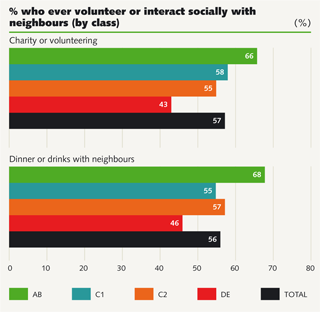 The romantic notions of a unique working-class community culture are certainly questioned by some of this data. It is worth noting that 46% of DE respondents say that they have dinner or drinks with their neighbours, whilst 43% engage in charitable or voluntary activity. However, these questions (about engaging in charitable or voluntary work) are some of the most prone to false recall. Furthermore, working class groups socialise less with their neighbours (by 10%) than the overall average; 22% less than the abs.
The romantic notions of a unique working-class community culture are certainly questioned by some of this data. It is worth noting that 46% of DE respondents say that they have dinner or drinks with their neighbours, whilst 43% engage in charitable or voluntary activity. However, these questions (about engaging in charitable or voluntary work) are some of the most prone to false recall. Furthermore, working class groups socialise less with their neighbours (by 10%) than the overall average; 22% less than the abs.
Furthermore, this lower level of engagement runs right across the board. Contrary to popular perception, for example, DE voters are even less likely to go to the pub than other social groups. The following table shows the level of engagement of all social classes with a range of community activities (0 is never, 1 is less than once a month, 2 is at least once a month, 3 is at least once a fortnight, 4 is at least once a week):
| Total | AB | C1 | C2 | DE | |
| Go to a local pub | 1.63 | 1.73 | 1.68 | 1.73 | 1.37 |
| Involved in some form of sport | 1.23 | 1.53 | 1.31 | 1.17 | 0.8 |
| Do some charity / community work | 1.04 | 1.39 | 1.06 | 0.82 | 0.8 |
| Have dinner or drinks with neighbours | 1 | 1.19 | 0.95 | 1.06 | 0.77 |
| Attend a place of worship | 0.84 | 0.98 | 0.88 | 0.86 | 0.61 |
| Involved in some political activity | 0.48 | 0.58 | 0.5 | 0.55 | 0.25 |
There is the possibility of a ‘persecution complex’ amongst certain groups: those who feel constrained from saying what they truly believe – whether or not such persecution is true. If it is true, then their voice is not being heard; they are alienated. If it is not true, then they feel outside the system and alienated; therefore dislocated. This is illustrated in the table below:
Two groups which comprise more DE voters than the average are latent hostiles and active enmity. These two groups are far more likely than average to push back against ‘political correctness.’ This could imply that there are things that they feel they can’t say that they feel they want to. This isn’t a view that is shared amongst the identity ambivalents so there is something deeper at play than just class. However, C2, DE voters have the highest proportion who are pushing back against a denial of the right to express what they feel (interestingly C1 voters are the most ‘PC’ and this might be explained by the proportion of public sector workers found with this group.)
| There are some things that people should not be able to say about race and if necessary they should be prosecuted if they do | ||||
|---|---|---|---|---|
| Total | AB | C1 | C2 | DE |
| 58% | 59% | 62% | 55% | 55% |
| People should be allowed to say what they believe about race, however critical or offensive it might be | ||||
|---|---|---|---|---|
| Total | AB | C1 | C2 | DE |
| 42% | 41% | 38% | 45% | 45% |
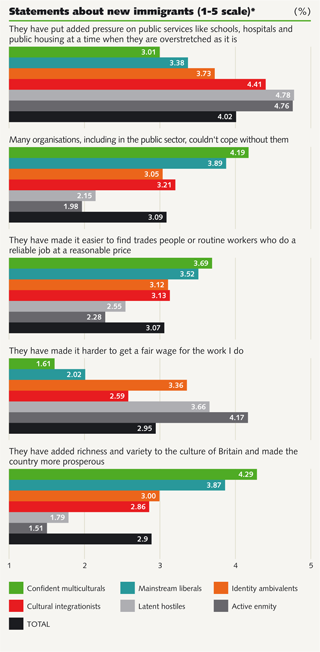 Issue refraction through the politics of identity
Issue refraction through the politics of identity
A political dynamic refracts individual issues through pre-formed frames of perception. The ‘tribe’ to which you belong steers your outlook on particular issues in a certain direction. One of the tests of the utility of the new politics of identity outlined in this report is the degree to which this is occurring. The table below shows some compelling evidence that it might well be.
The first two statements are, on balance, probably true (see House of Lords The Economic Impact of Immigration for detailed analysis and evidence.) 20 Net immigration does add pressure to public services. But many organisations, including in those in the public sector, could not cope without migrant workers. And yet there is almost a two-point difference between Confident Multiculturals and Latent Hostiles on the ‘pressure’ question. On the ‘coping’ question, there is a further two-point difference between these two ‘tribes.’ Whatever the broad objective reality, which identity ‘tribe’ you belong to skews your outlook and perception.
The other statements on this table are more subjective. One further issue is worthy of note: the degree to which respondents consider that immigrants have made it ‘harder to get a fair wage for the work I do.’ Immigration impacts certain types of workers more than others.As a recent report by the House of Lords reported on the basis of academic research into the impact of immigration on wages:
“This work suggests that every 1% increase in the ratio of immigrants to natives in the working age population ratio led to a 0.5% decrease in wages at the 1st decile (the lowest 10% of wage earners), a 0.6% increase in wages at the median, and a 0.4% increase in wages at the 9th decile. These effects are fairly modest.” 21
It is little surprise that the worst impacts are among those ‘tribes’ who are the least economically advantaged: Identity Ambivalents, Latent Hostiles, and Active Enmity.
Whether that is an accurate description of their actual situation is impossible to know. What could be happening is an interplay between perception and experience. That is a defining feature of a political dynamic. British politics, and peoples’ political understanding, is refracted through this politics of identity. That can, unfortunately, weigh heavily on attitudes towards particular groups.
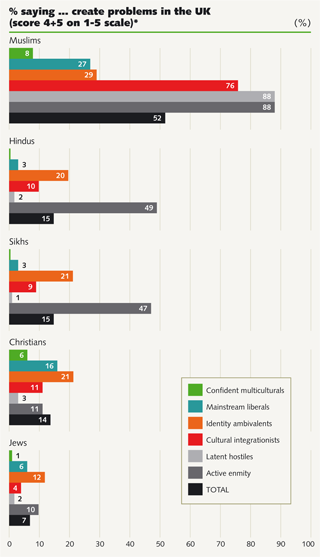 Attitudes to Muslims/ Islam
Attitudes to Muslims/ Islam
By and large the respondents in the survey believe that religion is a private activity which should have little influence on the laws of the land. Over two-thirds (68%) hold this view. Overall, however, religion is not seen as a force for good. Only 23% consider that religion is important to them personally and the same number see it as a force for good in the UK.
All religions are not equal, however. Islam as a religion and Muslims generally face very strong negative attitudes from a broad swathe of the population. Baroness Warsi appears to have had a point about the dinner table respectability of Islamaphobia. It is certainly very widespread in English society.
Just over half of respondents believe that Muslims ‘create problems in the UK.’ Identity Ambivalents share a closer affinity with Mainstream Liberals and Confident Multiculturals on this point. Once again this underlines the fact that the Identity Ambivalents more focused on the economy and perceptions on fairness than the Cultural Integrationists. (The majority of Muslims surveyed are in this group, though remain only a small part of it.) There is a huge gulf between the Muslim community and other groups in the perception of others and this obviously can lead to feelings of animosity and potential violence, on one side, and alienation and extremism on the other.
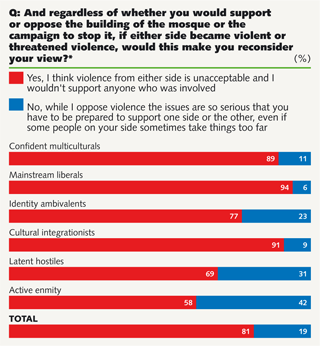 Perhaps this is most clearly demonstrated by reactions to the question about their reaction to an application to build a new mosque in their area.
Perhaps this is most clearly demonstrated by reactions to the question about their reaction to an application to build a new mosque in their area.
In total, 43% would support the campaign to stop the mosque against 19% who would oppose such a campaign. This is quite a startling figure. People are making their decision based solely on their opposition to an Islamic building and the image and stereotype that conjures up.
This is one of the most clearly divided questions in the survey: on one side are the Confident Multiculturals and the Mainstream Liberals and on the other the Latent Hostiles and the Active Enmity. The broad point, though, is that there is a gulf of understanding and acceptance between Islam and a large portion of the UK population – as much 50 per cent. This is a matter of urgent concern.
It is clear that violence polarises opinion. The group with the closest view to the Latent Hostiles and Active Enmity is the Cultural Integrationists.
As soon as violence becomes part of the equation there is a firewall between the Cultural Integrationists and the Latent Hostiles (see above graph). A belief in authority and order is emblematic of the Cultural Integrationists. As long as right-wing parties and groups such as the BNP and the EDL are associated with violence there is a firewall in place between them and mainstream society. Nearly a quarter (23%) of Identity Ambivalents do not see violence, or the threat of violence, as sufficient to make them change their mind. However, what if the threats of violence were not there? Is there political space for a different kind of identity-focused party of the Right?
Political vacuum on the right of the identity axis?
Threats to public order or threats and acts of violence build a firewall between the political Right and other groups that, to a degree, quarantines Latent Hostility and Active Enmity. As a purely hypothetical exercise, a question which outlined a fairly sanitised version of an English nationalist, anti-Muslim extremism, anti-immigration party was asked. The wording of this question was relatively benign and it was not linked to any individual or existing political brand. Nonetheless, the numbers do show a clear appetite for a right-wing English nationalist party.
The potential support for a more respectable right-wing party is a worrying development. To date, the UK has been ‘lucky’ that it has not had politically or electorally successful right-wing parties: they have been aggressive, disorderly, spill over into violence, or, in the case of UKIP, they are obsessive about a single issue. Right-wing parties have grown more spectacularly on the continent, most notably in The Netherlands, Italy, France, Switzerland, Austria and Denmark. What is clear, however, is that the lack of a similar right-wing party here is not due to the lack of potential support or even the British/English being any more moderate. Simply, there has not been a presentable political face for this mood.
Whether a new right-wing party emerges remains to be seen. It would be dependent on a number of factors. But what is clear is that the appetite for a new party will grow if the mainstream political parties fail to understand and deal with the new identity-driven landscape. Left unaddressed, a new party could, as our survey graphically demonstrates, not only appeal to those among the Latent Hostiles and Active Enmity, but also prove attractive to some in the Culturally Integrationists and Identity Ambivalents ‘tribes’.
The future, however, is not set in stone and while this survey flags up very real concerns and alarming attitudes, there is plenty of ground for a positive politics of cultural pluralism, authentic patriotic pride, and a fair distribution of access to services and distribution of opportunity of income.
Politics that offers a more compelling vision for people’s everyday concerns, as well as respects and understands their cultural identity, will ensure that the political mainstream feels a connection to the mainstream parties. The growth of the Right will be quarantined, too, if such efforts can be made.
In this regard, more must be offered by all of the mainstream parties. The Conservatives must understand the economic and social damage that austerity could do to many in the mainstream. Labour must realise that it is no longer a voice for the real mainstream. Both parties have much to do.
Notes
15. http://www.corecities.com/home
16. http://www.bbc.co.uk/blogs/thereporters/markeaston/ 2011/02/fairs_fair.html
17. See Jonathan Rutherford and Jon Cruddas http://www.progressonline.org.uk/articles/article.asp?A=7451
18. Robert Putnam. E Pluribus Unum: Diversity and Community in the Twenty-first Century. The 2006 Johan Skytte Prize Lecture. Scandinavian Political Studies, Vol. 30 - No.2, 2007.
20. http://www.publications.parliament.uk/pa/ld200708/ldselect/ldeconaf/82/8202.htm


